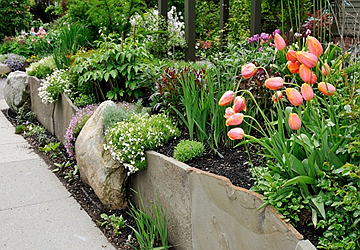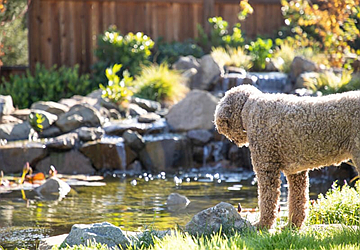Uncover 'How To Create A Safe Backyard For Your Dog: Tips For A Pet-Friendly Landscape.' Dive into essential strategies to ensure your outdoor space is both fun and secure for your four-legged friend.
A backyard can be a paradise for your dog, offering endless opportunities for play, exploration, and relaxation. However, not every garden is inherently safe for our canine companions.
"How To Create A Safe Backyard For Your Dog: Tips For A Pet-Friendly Landscape" is your
comprehensive guide to transforming any outdoor space into a haven where your dog can roam freely without risks, ensuring fun and safety are in perfect harmony.
For many dog owners, a backyard is more than just an outdoor space; it's an extended playground for their beloved canine companions. From chasing balls to sunbathing, these areas offer dogs a slice of nature outside their home. However, ensuring your yard is a dog-friendly backyard is paramount to your pet's safety. Here's how to seamlessly combine aesthetics with functionality, crafting a pet-safe landscaping paradise.
Before diving into the design elements, it's essential to understand dog behavior. Dogs are curious creatures with specific needs. Recognizing their behavior patterns helps tailor a backyard design for dogs that caters to play and relaxation.

Ingestion of several common garden plants by a dog can result in hazardous effects. Do your research before planting, and avoid plants that could become a problem, such as oleander, foxglove, and several types of lilies. Choose plants like rosemary, thyme, and marigolds instead if you have a pet in the house.
A fence is the first line of defense in dog-proofing your yard. Ensure it's tall enough to deter jumpers and embed a few inches into the ground to prevent diggers from escaping. Consider materials that can withstand the elements and the occasional rough play.
It is possible to reduce the amount of wear and tear on the rest of your garden by designating a specific area as a play area. Think of incorporating some long-lasting toys, tunnels, and agility equipment. Not only does this keep children occupied, but it also provides terrific stimulation for their bodies and minds.
Protection from the sun's harmful rays is essential for canines, just as it is for people. Incorporate shade-providing structures into the design, such as pergolas, shade sails, or plant trees, so there is always a pleasant place to sit and rest.

If you enjoy water features, ensure they are not hazardous to your pet's health. Keep your dog away from ponds too deep to climb out of if it should fall in easily. Think about getting them a pet-friendly fountain or a splash pad with shallow pools so they can play in clean water and drink it.
Ingestion of several standard garden supplies, such as fertilizers and pesticides, may result in adverse health effects. Choose ingredients that are organic and safe for pets. Not only does this protect the well-being of your pets, but it also helps the world around them.
It's a fun activity for the dogs. Making pathways out of materials such as flagstone or smooth pebbles can provide them with a distinct path to investigate, allowing them to both demarcate their area and fulfill their requirement of physical activity for the day.
Ornaments and decorations for the garden that are very small can present a choking hazard. Always keep in mind the size of your dog and steer clear of anything it could be enticed to pick up with its mouth.
Keeping your garden tidy goes a long way in creating a pet-friendly garden. Regularly check for any sharp objects, clear away trash, and keep the lawn mowed to reduce the presence of ticks and pests.
The occasional chew on grass or plants is a treat many dogs look forward to. Plant grasses and herbs, such as wheatgrass, are safe for dogs to consume, so they have something to graze on that won't make them sick.
Dogs tend to track a lot of dirt into the house after having a good time outside. Towels, water, and a brush should be placed in a compact cleaning station close to the door. This item is beneficial on wet days when dirty paws are practically unavoidable.
Dogs' keen sense of smell is the primary reason for their colorful and varied environment. This olfactory understanding is essential to their perception of the world and is used for more than only tracking and feeding. You can improve their time spent in the great outdoors by providing a sensory garden.
You can provide your pet with a therapeutic and delightful experience by planting aromatic herbs or fragrant shrubs like lavender, chamomile, or mint. For instance, the aroma of lavender is calming, and it also has the potential to deter insects.
Incorporating such plants into your yard improves its aesthetic value. It provides your dog with a more stimulating and enjoyable outdoor experience by exposing it to various aromas.
It's lovely when birds or other animals visit, but you should know what else they can bring. It is essential to keep your dog away from any plants or feeders that could attract creatures that are hostile to dogs or that could become a meal for your dog.
Conduct routine safety checks to identify and eliminate any potential hazards in the yard. Check the fences for any potential weak spots, watch for poisonous mushrooms that may have sprouted, and look for any foreign objects that may have made their way inside.
In conclusion, creating a harmonious space for you and your dog isn't challenging with the proper guidance. By prioritizing safety and being mindful of your dog's needs, your yard can become a haven of fun and relaxation. The joy of seeing your furry friend bask in the sun or play with abandon in their dog-friendly backyard is immeasurable, making every effort worth it.